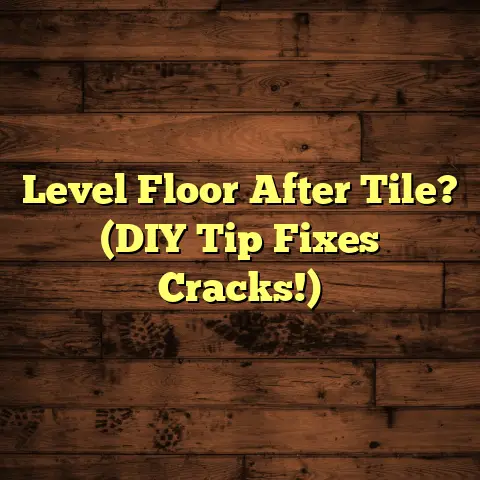Mount Island to Floor (7 Pro Install Steps!)
Today, I’m going to walk you through a project that might seem a bit daunting: transitioning from a mount island (think kitchen island, or a raised platform) to a new floor.
We’ll break down the process into 7 manageable steps, covering everything from budgeting to those final, satisfying finishing touches.
Introduction: Budget Options for Flooring Installation
Let’s be real, flooring projects can hit your wallet hard. Before we even think about tools or materials, we need to talk budget.
What can you realistically afford?
It’s a question that will guide every decision we make, ensuring you get the most bang for your buck without compromising on quality or longevity.
Budget Breakdown:
- Material Costs:
The material you choose is going to heavily influence the overall cost. Let’s look at some common options:
-
Hardwood: The king of flooring!
Beautiful, durable, and adds serious value to your home. However, it’s also the priciest. Expect to pay anywhere from $8 to $25+ per square foot installed, depending on the species (oak, maple, walnut, etc.) and finish.
Pros: Timeless appeal, long-lasting, adds value. Cons: Expensive, susceptible to moisture, requires maintenance.
-
Laminate: A budget-friendly alternative to hardwood.
It mimics the look of wood (or even tile!) at a fraction of the cost. You’re looking at $3 to $12 per square foot installed.
Pros: Affordable, easy to install, water-resistant. Cons: Doesn’t add as much value as hardwood, can look less realistic, shorter lifespan.
-
Vinyl: Versatile and waterproof, vinyl is a great option for kitchens and bathrooms.
Luxury vinyl plank (LVP) is particularly popular. Expect to pay $3 to $10 per square foot installed.
Pros: Waterproof, durable, easy to clean, affordable. Cons: Can dent easily, doesn’t add as much value, can look less luxurious.
-
Tile: Classic and durable, tile is a great choice for high-traffic areas.
Porcelain and ceramic are common options. Expect to pay $5 to $20+ per square foot installed.
Pros: Durable, water-resistant, easy to clean, wide variety of styles. Cons: Can be cold, hard underfoot, difficult to install.
-
Carpet: Soft and comfortable, carpet is best for bedrooms and living rooms.
Expect to pay $3 to $8 per square foot installed.
Pros: Comfortable, warm, affordable, reduces noise. Cons: Stains easily, requires regular cleaning, can trap allergens.
Pro Tip: Don’t forget to factor in waste!
I typically add 10-15% to my material calculations to account for cuts and mistakes.
Example: Let’s say you’re installing LVP in a 200 sq ft space.
At $5/sq ft, your material cost is $1000. Add 10% waste ($100), and your total material cost is $1100.
- Labor Costs:
This is where things can vary wildly.
Hiring a professional installer will obviously cost more than doing it yourself. But consider this: a professional will likely do the job faster, with fewer mistakes, and often offers a warranty on their work.
-
DIY Installation: You’ll save on labor costs, but you’ll need to invest in tools and spend your own time.
-
Professional Installation: Expect to pay anywhere from $2 to $8+ per square foot for labor, depending on the material, complexity of the job, and your location.
Factors affecting labor costs:
* **Project Complexity:** Working around a mount island adds complexity. * **Location:** Labor costs vary widely by region. * **Contractor Experience:** More experienced contractors usually charge more. Personal Experience: I once had a client try to install hardwood themselves to save money. They ended up damaging half the boards and had to call me in to fix it. In the end, it cost them more than if they had hired me from the start!
- Additional Expenses:
Don’t forget these often-overlooked costs:
-
Underlayment: Provides cushioning, sound insulation, and moisture protection. Essential for many flooring types. Expect to pay $0.50 to $3 per square foot.
-
Adhesives: Needed for some types of flooring, like vinyl and tile.
-
Tools: You might need to purchase or rent tools like saws, measuring tapes, spacers, and tapping blocks.
-
Subfloor Repair: If your subfloor is damaged or uneven, you’ll need to repair it before installing the new flooring. This can add significant costs.
Unforeseen Expenses: Always, always, have a buffer in your budget for unexpected issues. I recommend at least 10% of the total project cost.
- Financing Options:
If you don’t have the cash on hand, here are a few options:
- Personal Loans: Can offer lower interest rates than credit cards.
- Credit Cards: Convenient, but often come with high interest rates.
- Store Financing: Offered by some flooring retailers, but be sure to read the fine print.
Financing vs. Saving: I always recommend saving up for a project if possible. You’ll avoid paying interest and reduce your overall costs.
-
Cost-Saving Tips:
-
Shop Sales: Flooring retailers often have sales and promotions.
- Consider Off-Brand Materials: You can often find quality materials from lesser-known brands at lower prices.
- Time Your Project: Contractors are often less busy during off-peak seasons (like winter), so you might be able to negotiate a better price.
- DIY Some Tasks: Even if you hire a professional installer, you can save money by doing some of the prep work yourself, like removing the old flooring and cleaning the subfloor.
Okay, now that we’ve got a handle on the budget, let’s move on to the actual installation process.
Step 1: Planning and Preparation
This is where the magic really happens.
Proper planning is the key to a successful flooring project. Rushing into things is a recipe for disaster.
-
Measure Accurately: Use a measuring tape to determine the length and width of the area you’ll be flooring.
Multiply these numbers to calculate the square footage. Don’t forget to account for any nooks, crannies, or obstacles.
-
Calculate Material Requirements: Based on the square footage, determine how much flooring material you’ll need.
Remember to add that 10-15% for waste!
-
Select the Right Underlayment: Choose an underlayment that’s appropriate for your flooring material and subfloor.
Consider factors like moisture resistance, sound insulation, and cushioning.
-
Prepare the Subfloor: The subfloor is the foundation of your new flooring. It needs to be clean, level, and dry.
We’ll talk more about this in Step 3.
Step 2: Gathering Tools and Materials
Alright, time to assemble your arsenal! Here’s a list of essential tools you’ll likely need:
- Measuring Tape: A good quality measuring tape is essential for accurate measurements.
- Pencil: For marking cuts and measurements.
- Saw: A circular saw or miter saw is needed for cutting flooring boards or tiles.
- Tapping Block: Used to gently tap flooring boards into place without damaging them.
- Spacers: Used to maintain consistent spacing between flooring boards or tiles.
- Hammer: For driving nails or tapping blocks.
- Pry Bar: For removing old flooring.
- Level: To ensure your subfloor is level.
- Moisture Meter: To check the moisture content of your subfloor.
- Safety Glasses: Protect your eyes from debris.
- Knee Pads: Save your knees!
Where to Purchase/Rent Tools:
- Home Improvement Stores: Like Home Depot or Lowe’s.
- Tool Rental Centers: A good option if you only need a tool for a short period.
- Online Retailers: Like Amazon.
Budget-Friendly Options:
- Borrow Tools: Ask friends or family if you can borrow any tools.
- Buy Used Tools: Check online marketplaces like Craigslist or Facebook Marketplace for used tools.
- Rent Instead of Buy: If you only need a tool for a one-time project, renting is usually more cost-effective than buying.
Quality Materials:
Don’t skimp on quality! Cheaper materials might save you money upfront, but they’re likely to wear out faster and require replacement sooner.
Step 3: Preparing the Area
Now, let’s get down to the nitty-gritty.
-
Clear the Area: Remove all furniture, rugs, and other items from the room.
-
Remove Existing Flooring: This can be a messy job, so wear a mask and eye protection.
Use a pry bar to remove old flooring boards or tiles.
-
Clean the Subfloor: Sweep, vacuum, and scrape away any dirt, debris, or adhesive residue.
-
Inspect the Subfloor: Look for signs of damage, such as cracks, holes, or rot.
Repair any damage before installing the new flooring.
-
Check for Moisture: Use a moisture meter to check the moisture content of the subfloor.
If the moisture level is too high, you’ll need to address the issue before proceeding.
Pro Tip: Moisture can ruin your new floor!
I’ve seen countless flooring installations fail because of moisture problems. Don’t skip this step!
-
Acclimate Flooring Materials: Allow the flooring materials to acclimate to the room’s temperature and humidity for at least 48 hours before installation.
This will prevent warping or buckling after installation.
Step 4: Installing the Flooring
Here’s where the fun begins! I’m going to give you a general overview of the installation process. Keep in mind that the specific steps will vary depending on the flooring material you’ve chosen.
-
Start with a Straight Line: Use a chalk line to mark a straight line along the starting wall.
This will ensure that your flooring is installed straight and even.
-
Install the First Row: Carefully install the first row of flooring boards or tiles, following the chalk line.
Use spacers to maintain consistent spacing between the flooring and the wall.
-
Continue Installing: Continue installing the flooring, row by row, making sure to stagger the seams for a more natural look.
-
Cut Around Obstacles: Use a saw to cut around obstacles like pipes, door frames, and the mount island.
-
Secure the Flooring: Depending on the flooring material, you’ll either nail, glue, or click the boards or tiles into place.
-
Techniques Specific to Different Materials:
- Hardwood: Nailing is the most common method. Use a flooring nailer for best results.
- Laminate: Typically uses a click-lock system.
- Vinyl: Can be glued down or use a click-lock system.
- Tile: Requires thin-set mortar and grout.
Step 5: Finishing Touches
Almost there! These finishing touches will make your new floor look polished and professional.
-
Trim and Install Baseboards/Moldings: Cover the expansion gap between the flooring and the wall with baseboards or moldings.
Use a miter saw to cut the baseboards or moldings to the correct angle.
-
Seal or Finish the Flooring (If Applicable): Some flooring materials, like hardwood, require sealing or finishing.
Follow the manufacturer’s instructions.
-
Clean the New Floor: Use a damp cloth to clean the new floor.
Avoid using harsh chemicals or abrasive cleaners.
Step 6: Final Inspection and Adjustments
Time to put on your inspector hat!
-
Check for Gaps or Unevenness: Look for any gaps between the flooring boards or tiles.
Check for unevenness using a level.
-
Address Any Issues: If you find any issues, address them promptly.
You might need to replace a damaged board or tile, or adjust the spacing.
-
Ensure Aesthetics and Functionality: Make sure that the flooring meets your expectations in terms of aesthetics and functionality.
Does it look good? Does it feel good underfoot?
-
Common Post-Installation Issues:
- Squeaking: Can be caused by an uneven subfloor or loose boards.
- Buckling: Can be caused by moisture or improper installation.
- Gapping: Can be caused by expansion and contraction due to temperature changes.
Step 7: Enjoying Your New Floor
Congratulations! You’ve successfully installed a new floor.
Take a moment to admire your handiwork and enjoy your new space. You’ve invested time, effort, and money into this project, so take pride in your accomplishment.
And remember, a well-maintained floor will last for years to come, adding value and beauty to your home.
So, what are you waiting for? Get started on your flooring project today!
I hope this guide has been helpful. If you have any questions, feel free to ask in the comments below.
Happy flooring!





